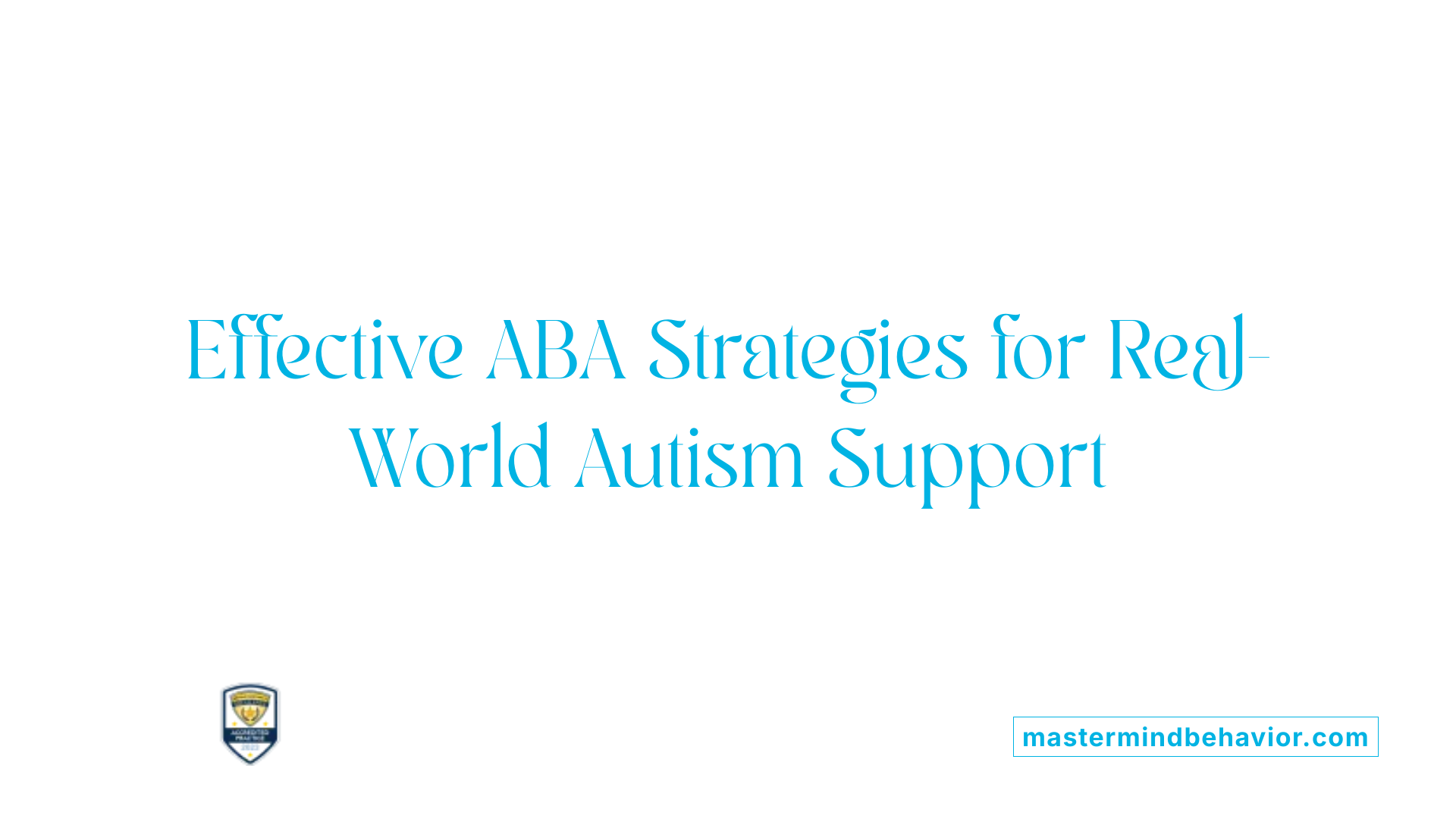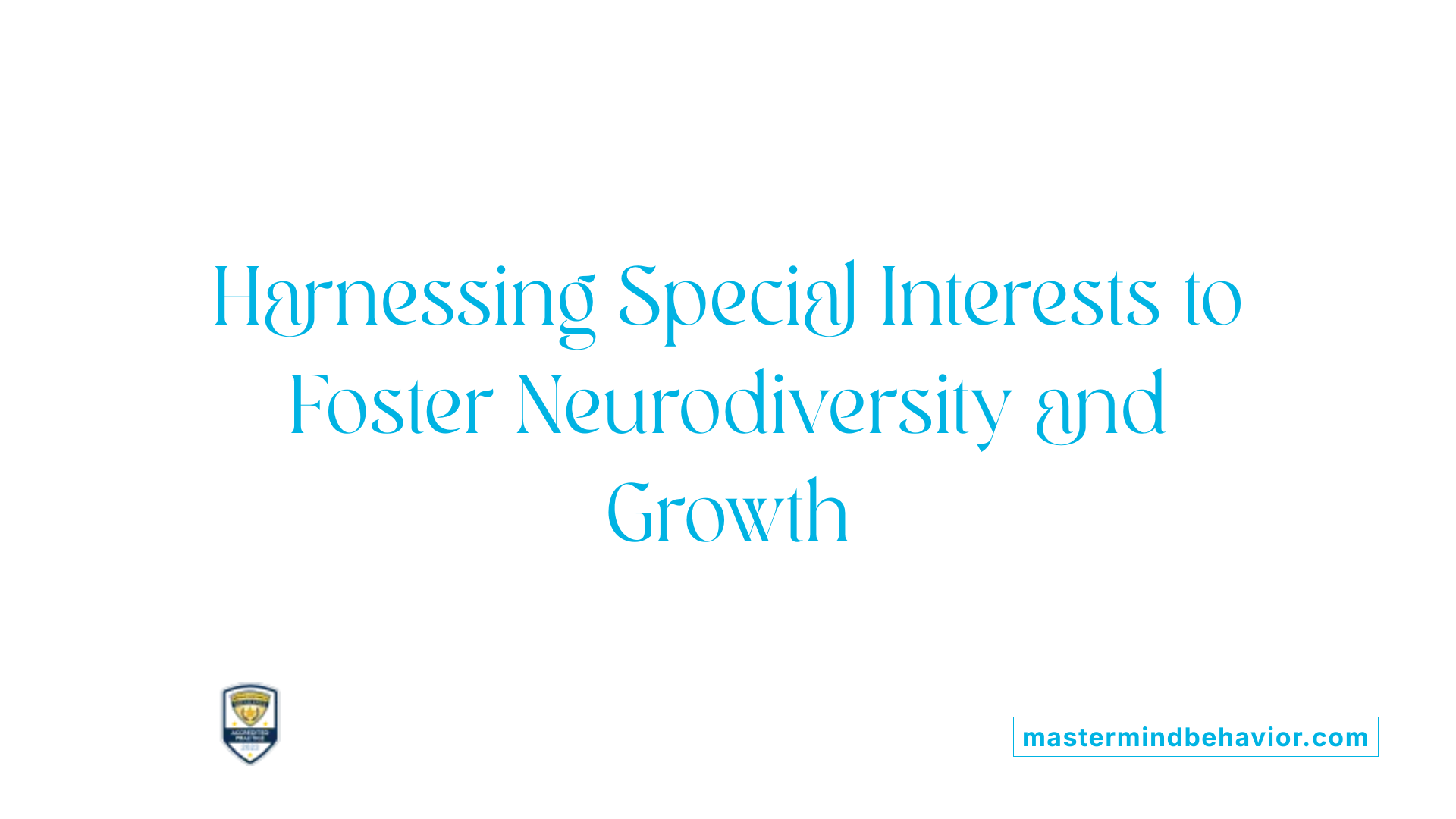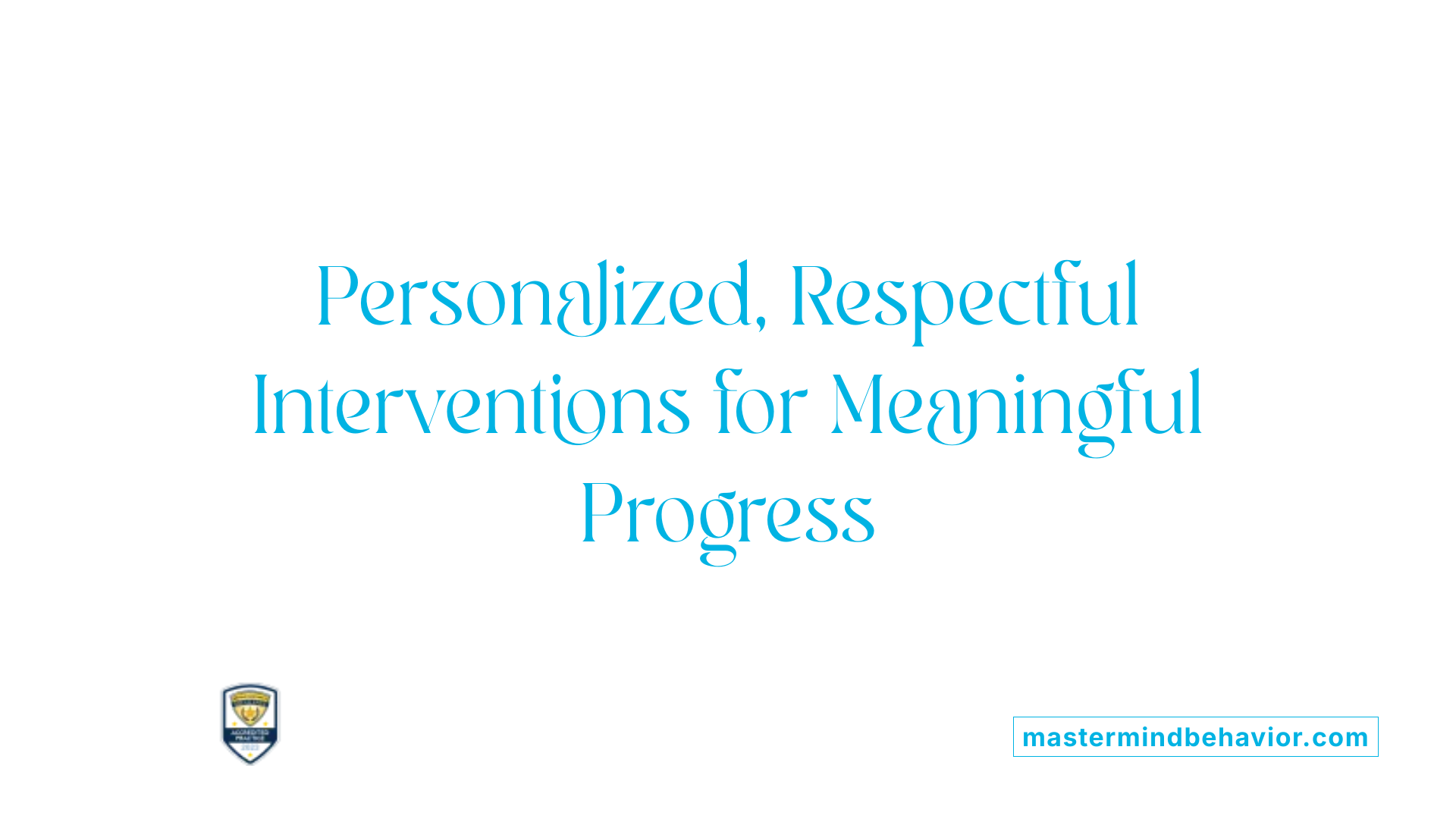How ABA Therapy Reduces Perseveration On Preferred Topics

Understanding Perseveration and the Role of ABA Therapy
Perseveration—repetitive behaviors or speech on preferred topics—is a hallmark feature of autism spectrum disorder (ASD). While often seen as a challenge, these behaviors can be effectively managed through targeted interventions like Applied Behavior Analysis (ABA). This article explores how ABA therapy reduces perseveration by examining its mechanisms, effectiveness, and practical applications, emphasizing the importance of individualized strategies that respect neurodiversity.
Functional Analysis as a Foundation for Targeted Intervention
What is the role of functional analysis in understanding perseverative speech?
Functional analysis plays a critical role in identifying the specific functions that maintain perseverative speech in individuals with autism spectrum disorder (ASD). In this process, behaviors are observed and tested within controlled settings to determine what reinforces them. For example, if a child repeatedly talks about the same topic, functional analysis can reveal whether this pattern is maintained by social reinforcement, such as gaining attention from peers or adults.
How does functional analysis identify social reinforcement as a maintaining factor?
In many cases, perseverative behaviors are sustained by social interaction, especially attention. Confirmatory evidence from functional analysis demonstrates that providing attention on a consistent schedule—without contingently reinforcing the perseverative speech—can help identify social reinforcement as the primary maintaining factor. When attention only occurs on a fixed-time schedule and not in response to perseverative speech, it indicates that the behavior is maintained specifically by social attention, rather than by internal stimuli or escape from demands.
What strategies are used based on these findings?
Once the function of perseverative speech is identified, targeted interventions can be implemented. A commonly used approach involves combining noncontingent reinforcement (NCR) with extinction. NCR involves delivering attention at fixed intervals regardless of the behavior, which helps to diminish the reinforcement previously gained from perseverative speech. Extinction, on the other hand, involves withholding the attention contingent on the perseverative behavior, weakening its occurrence.
How effective is this targeted approach?
Research shows that such interventions can lead to impressive reductions in perseverative speech. For instance, in an intervention with an 11-year-old boy with ASD, these strategies resulted in a 98.5% decrease in perseverative speech. The success of this approach underscores the importance of thorough functional analysis to guide treatment, ensuring that interventions address the specific social reinforcement maintaining the behavior.
Additional considerations for intervention
Incorporating clients' interests and perseverance in therapy not only makes interventions more engaging but also enhances generalization. Using preferred topics, hobbies, or activities as part of social engagement strategies—such as social clubs focused on interests—can boost social interactions. Furthermore, involving peers in social activities and designing structured, predictable environments support sustainable progress. Reducing perseverative speech while respecting individuals’ interests fosters both social skill development and neurodiversity acknowledgment.
Addressing the Social Reinforcement Maintaining Perseverative Speech
How does social reinforcement serve as a maintainer of perseverative speech?
Research indicates that perseverative speech in individuals with autism spectrum disorder (ASD) is often maintained by social reinforcement, especially attention. Functional analysis confirms that such behaviors are reinforced when individuals receive attention from others. When a child persistently talks about a specific topic or interest, they are effectively gaining social engagement, which encourages them to continue these behaviors.
Strategies to modify social reinforcement patterns
Interventions such as noncontingent reinforcement (NCR) combined with extinction (EXT) have shown promising results. NCR involves delivering attention on a fixed-time schedule regardless of the behavior, which reduces the need for the individual to seek attention through perseverative speech.
In practice, this means providing consistent attention during set intervals, helping the individual find alternative ways to access social interaction. Extinction involves withholding reinforcement for perseverative speech, thereby decreasing its future occurrence.
Additionally, incorporating peer-mediated interventions can promote more natural social interactions. Peers are encouraged to initiate conversations and engage with individuals around their interests, facilitating generalization of social skills outside structured therapy sessions.
Structured environments with predictable routines and involvement of typically developing peers further support social engagement. When therapy goals are tailored to include the individual's special interests—like video games, cartoons, or hobbies—there’s a higher likelihood of fostering meaningful social initiations.
Offering personalized themes based on perseverative interests not only motivates the individual but also helps incorporate social exchanges into everyday activities like lunchtime conversations or club participation. For example, encouraging a teenager to discuss their favorite game during social interactions makes the conversations more relevant and engaging.
Ultimately, combining behavioral strategies such as NCR and extinction with inclusive, interest-based interventions creates a supportive environment where perseverative speech can be reduced, and social skills can flourish, respecting neurodiversity and promoting functional communication.
Summary Table:
| Strategy | Purpose | How it Works | Additional Benefits |
|---|---|---|---|
| Noncontingent Reinforcement (NCR) | Reduce problem behaviors | Providing attention on a fixed schedule | Decreases need for attention-driven speech |
| Extinction | Decrease perseverative speech | Withholding reinforcement for the target behavior | Reduces behavior over time |
| Peer-Mediated Intervention | Promote generalization | Peers facilitate natural interactions | Enhances social integration |
| Personalized, Interest-Based Goals | Increase engagement | Focus on individual interests | Improves motivation and communication |
This comprehensive approach helps support individuals with ASD by addressing the social reinforcement that maintains perseverative speech, leading to more meaningful social interactions and communication skills.
Interventions with High Effectiveness in Managing Perseveration

How effective are ABA interventions in managing perseveration?
Applied Behavior Analysis (ABA) methods have demonstrated high success rates for reducing perseverative speech among individuals with autism spectrum disorder (ASD). One particularly effective approach combines noncontingent reinforcement (NCR) with extinction. In a notable case, an 11-year-old boy showed a 98.5% decrease in perseverative speech following this intervention. The treatment was designed to deliver attention on a fixed-time schedule while placing perseverative behaviors on extinction, directly targeting the social reinforcement—specifically attention—that maintained the behavior.
Functional analysis helped confirm that the perseverative speech was maintained by social attention, guiding therapists to tailor the intervention accordingly. This strategy not only reduces the problematic behavior but also promotes healthier social interactions.
Further, interventions that leverage the individual’s special interests or hobbies—referred to as perseverations or hyper-fixations—can be highly beneficial. For example, incorporating preferred activities like video games or cartoons into speech-language therapy can help individuals regulate themselves and engage more meaningfully.
Aside from behavioral techniques, creating structured, predictable environments and involving typical peers in peer-mediated interventions enhance social skills development. Peer facilitation encourages generalization of social behaviors beyond structured therapy settings, increasing opportunities for adolescents with ASD to initiate and sustain social engagement.
Research supports including individualized themes based on perseverative interests within social clubs and unstructured activities, significantly improving social initiations. Goals like requesting permission to discuss personal interests and engaging in conversations about hobbies are practical strategies that foster functional and personalized communication.
In summary, ABA interventions, particularly those combining NCR with extinction, prove highly effective for managing perseverative speech. The integration of personalized interests and peer involvement not only boosts immediate behavior change but also supports long-term social skill development.
| Intervention Type | Effectiveness | Notes | |---------------------|--------------|----------------------------| | NCR + Extinction | Up to 98.5% reduction | Social attention maintained behavior | | Peer-mediated | Significant improvements in social interactions | Facilitates generalization | | Incorporating Interests | Increased engagement and social initiations | Customized therapy goals |
Overall, evidence indicates that with targeted ABA strategies, individuals with ASD can achieve meaningful reductions in perseveration, leading to better social functioning over time.
Application of ABA Strategies in Real-World Settings

How can ABA techniques be applied to manage perseveration behaviors?
Applied Behavior Analysis (ABA) offers effective strategies for managing perseveration behaviors, such as perseverative speech, especially in individuals with autism spectrum disorder (ASD). A crucial initial step involves conducting a functional analysis to understand what maintains the behavior. For example, if social reinforcement, particularly attention, is identified as the main maintaining factor, targeted interventions can be implemented.
One commonly used approach is noncontingent reinforcement (NCR), which involves providing access to the preferred reinforcement—like attention—on a fixed-time schedule. This means the individual receives attention regularly, reducing the need to seek it through perseverative speech. In addition, placing the perseverative behavior on extinction—that is, no longer reinforcing it—can significantly diminish the behavior.
Combining NCR with extinction has shown to be particularly effective, resulting in substantial decreases in perseverative speech, as demonstrated in case studies with children and adolescents. Over time, intervention plans may incorporate schedule thinning, gradually increasing the time between reinforcement to promote greater independence.
Beyond behavior reduction, integrating the individual's special interests into intervention helps foster social engagement and generalization of skills. For example, incorporating preferred activities like cartoons or video games into therapy sessions not only motivates participation but also enhances social interactions. Peer-mediated approaches, where typical peers facilitate social exchanges related to shared interests, further improve social initiatives during unstructured activities like lunchtime.
Tailoring these ABA strategies to the individual's specific needs—guided by functional analysis—ensures more effective and sustainable behavior management. This personalized approach helps individuals with ASD develop functional communication skills and better social integration, respecting neurodiversity and promoting meaningful progress.
Perseveration in Autism: A Natural yet Manageable Aspect

What is the understanding of perseveration in the context of autism and ABA therapy?
Perseveration is a common characteristic among individuals with autism, involving repetitive speech patterns, behaviors, or routines that persist over time. For example, a child might repeatedly insist on a specific activity or phrase, which can serve as a source of comfort or stability.
This behavior often functions as a way to cope with sensory overload, anxiety, or stress. It helps the individual create a predictable environment, providing a sense of control.
In ABA therapy, understanding the purpose behind perseveration is crucial. Therapists conduct functional analyses to determine whether the behavior is maintained by attention, sensory stimulation, or avoiding certain tasks.
Once the function is identified, targeted interventions are implemented. These may include using social reinforcement, such as giving attention when appropriate, and extinction, which involves withholding reinforcement for perseverative behaviors.
For example, an intervention might combine noncontingent reinforcement—delivering attention at regular intervals regardless of behavior—with extinction of the perseverative speech. This approach was successfully applied to an 11-year-old boy with autism, leading to a 98.5% decrease in perseverative speech.
Furthermore, addressing perseveration with personalized strategies can improve social engagement. Incorporating clients’ special interests—like video games or cartoons—can serve as meaningful topics during therapy or social activities, making progress more functional and respecting neurodiversity.
Targeted interventions also include creating structured environments with predictable routines and involving peers. Peer-mediated activities and social clubs centered around perseverative interests have shown to increase social initiations among adolescents with autism.
Overall, perseveration is viewed as a natural part of autism. With appropriate support strategies—like behavioral interventions that clarify functions of behavior and use individualized interests—behavior can be managed effectively, promoting better social and communication skills.
Incorporating Interests to Promote Social Engagement and Generalization
Using special interests as a motivational tool in ABA therapy can be highly effective for individuals with autism spectrum disorder (ASD). Many clients have strong interests or hobbies—commonly called perseverations or hyper-fixations—that can serve as gateways for engaging in functional communication. For example, a client passionate about video games or cartoons can be encouraged to request permission to discuss these topics or to initiate conversations about their favorite interests.
By integrating these interests into therapy sessions, speech-language pathologists can create more personalized and motivating goals. This approach not only fosters engagement but also promotes the ability to generalize skills beyond the therapy setting. For instance, goals may shift from basic turn-taking to participating in discussions about personal preferences, making the experience more meaningful and relevant.
Redesigning treatment goals to include clients' special interests enhances the likelihood of progress and helps respect neurodiversity. Such strategies include requesting permission to discuss interests, asking questions about preferred activities, and engaging in conversations related to hobbies. Incorporating interests into therapy makes the sessions more enjoyable and aligned with the individual’s strengths, which in turn supports improved social interaction and communication outcomes.
Research indicates that social clubs based on shared perseverative interests can significantly improve social engagement and initiate more social interactions among adolescents with ASD. Moreover, peer-mediated interventions, where typical peers facilitate social exchanges, have demonstrated effectiveness in generalizing social skills outside structured environments. Creating structured, predictable settings with involvement of typical peers and tailored activities around perseverative interests can contribute greatly to the success of social interventions for adolescents.
Overall, embracing individual interests not only enriches therapy but also aligns with a broader understanding of neurodiversity, recognizing that these passions are valuable and can be harnessed for positive development.
The Value of Special Interests in Therapy and Neurodiversity
 Recognizing the importance of special interests as assets rather than disorders is an essential perspective in autism intervention. These interests, often called perseverations or hyper-fixations, can serve as powerful tools for engagement and growth within therapy sessions.
Recognizing the importance of special interests as assets rather than disorders is an essential perspective in autism intervention. These interests, often called perseverations or hyper-fixations, can serve as powerful tools for engagement and growth within therapy sessions.
In the context of speech-language therapy, incorporating a client’s hobbies—such as video games, cartoons, or specific topics—can make treatment goals more meaningful and personalized. For example, instead of standard social skills instructions, therapists might encourage discussions about a client’s favorite interests or request permission to talk about their hobbies. This approach not only respects neurodiversity but also promotes generalization of skills across different environments.
How does ABA therapy address perseverative speech? Functional analysis is used to determine what maintains the behavior. Often, social reinforcement—particularly attention—is identified as the driving force behind perseverative speech. Once understood, interventions like noncontingent reinforcement (NCR) are implemented, providing attention on a fixed schedule to reduce the need for perseverative talk. Extinction procedures are also applied, where the problematic speech no longer results in reinforcement, encouraging reduction.
In addition to behavioral techniques, understanding the value of interests can help tailor interventions. For example, creating social clubs around a shared interest can increase social engagement and initiate conversations among adolescents with autism.
Furthermore, involving peers in structured, predictable environments can facilitate effective social interactions. Peer-mediated strategies, combined with the use of interests, have shown positive outcomes in promoting social initiation and ongoing engagement.
In summary, acknowledging and integrating special interests within therapy enhances not only the effectiveness of interventions but also supports neurodiversity. By leveraging these interests, speech-language pathologists and behavioral therapists empower clients to develop functional communication skills while respecting their unique preferences and strengths.
| Strategy | Implementation | Benefit |
|---|---|---|
| Incorporate interests into goals | Engage clients in discussions about favorite hobbies | Increased motivation and generalization |
| Use social clubs around interests | Create interest-based groups for social interaction | Improved social skills and peer engagement |
| Peer-mediated interventions | Typical peers facilitate social exchanges involving interests | Enhanced social initiation outside therapy |
| Adjust treatment goals | Focus on requesting or talking about personal interests | Functional communication and neurodiversity appreciation |
Fostering Social Skills Development in Adolescents with ASD
Using social clubs and peer interventions
Incorporating social clubs centered on perseverative interests can markedly boost social engagement among adolescents with ASD. These clubs provide a relaxed setting where teens can connect over shared hobbies, such as video games or cartoons. Peer-mediated interventions, where classmates facilitate interactions, further support the development of social skills. These approaches make socialization more natural and help generalize skills beyond structured therapy.
Structured environments and routine
Structured and predictable environments are essential for effective social interventions. When routines are clear, and activities are well-organized, adolescents feel more comfortable engaging with peers. Including typical peers in these settings can enhance the experience, making social interactions more meaningful. Such environments foster confidence and encourage ongoing participation in social activities.
| Approach | Benefits | Additional Considerations |
|---|---|---|
| Social clubs based on interests | Increased engagement, peer connections | Should be tailored to individual interests |
| Peer-mediated strategies | Promote social skill generalization | Require training for peer volunteers |
| Structured routines | Provide predictability and comfort | Can be integrated into daily activities |
The Importance of Individualized, Respectful Approaches

Tailoring interventions to individual interests
Integrating an individual's unique interests into therapy can significantly boost engagement and progress. In the case of an 11-year-old boy with autism spectrum disorder, his perseverative speech was maintained by attention, a social reinforcement. To address this, therapists employed a combination of noncontingent reinforcement (NCR) and extinction. Delivering attention at fixed intervals, while simultaneously placing perseverative speech on extinction, led to a remarkable 98.5% decrease in the behavior.
Using personalized strategies, such as incorporating passions like video games or cartoons into therapy, helps make interventions more relevant. Shifting goals from generic social skills like turn-taking to conversations about personal interests encourages natural, meaningful interactions. For example, asking permission to discuss a favorite hobby promotes both engagement and respect for the client’s preferences.
Supporting neurodiversity in therapy
Treatments that recognize and honor neurodiversity foster a more inclusive environment. Instead of viewing perseverative interests like hyper-fixations as problematic, therapists can see them as valuable tools. These interests can serve as a foundation for social clubs or structured activities that promote social initiations and engagement, especially among adolescents.
Involving peers through peer-mediated interventions and creating structured, predictable environments tailored around interests can help generalize skills beyond therapy sessions. Such approaches not only improve social outcomes but also validate neurodiverse ways of experiencing and interacting with the world, promoting acceptance and individual growth.
| Strategy | Description | Benefits |
|---|---|---|
| Personalization | Incorporating clients’ interests into goals and activities | Increased motivation and generalization |
| Peer Involvement | Using typical peers in social activities | Better social skills transfer |
| Structured Settings | Creating predictable environments based on interests | Enhanced comfort and learning |
Focusing on individualized, respectful approaches in autism interventions ensures that clients receive meaningful support that respects their identities and promotes genuine social participation.
Empowering Individuals Through Effective Intervention
Managing perseverative behaviors in autism is achievable through evidence-based ABA strategies that are personalized, functional, and respectful of neurodiversity. By understanding the underlying functions, employing targeted reinforcement techniques, and incorporating individual interests, clinicians can significantly reduce perseveration and promote social engagement and adaptive skills. These interventions not only improve quality of life but also foster greater independence and social inclusion for individuals with ASD.
References
- Functional Analysis and Noncontingent Reinforcement ...
- Using Perseverative Interests to Improve Interactions ...
- Recasting Perseveration as Passion
- Functional Analysis and Noncontingent Reinforcement ...
- Functional analysis and intervention of perseverative ...
- Understanding Perseveration in ABA Therapy for Parents
- Functional Analysis and Noncontingent Reinforcement ...
- Functional analysis and treatment of verbal perseverations ...
- Verbal Perseveration! Verbal Perseveration!
- Functional Analysis and Noncontingent Reinforcement ...
Recent articles

How ABA Therapy Builds Self-Care Independence In Teenagers
Empowering Teens Through Structured Interventions

Teaching Time Management Concepts Through ABA
Maximizing Success: Applying ABA to Teach Effective Time Management

How ABA Therapy Reduces Perseveration On Preferred Topics
Effective Strategies for Managing Perseverative Behaviors in Autism

ABA Therapy To Reduce Impulsivity In Classroom Environments
Transforming Classroom Behavior: The Impact of ABA Therapy on Impulsivity

The Role Of ABA Therapy In Developing Goal Setting Skills
Harnessing ABA for Building Future Goals

Preparing For ABA Therapy: What Families Should Do Before The First Session
Essential Steps for a Smooth Start to ABA Therapy



